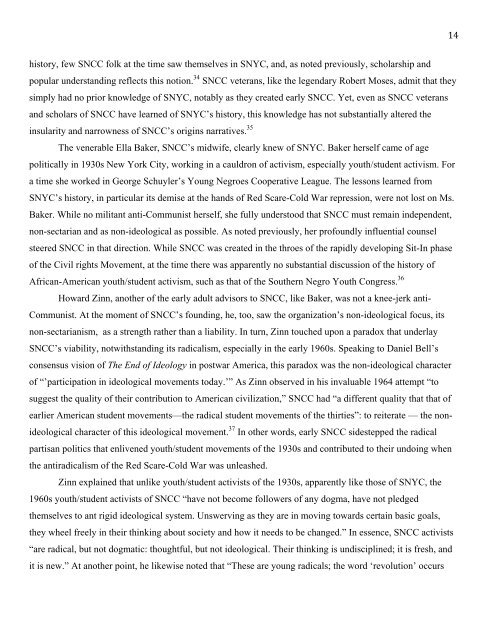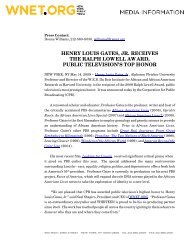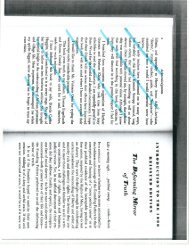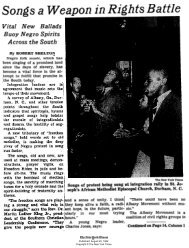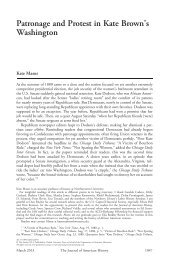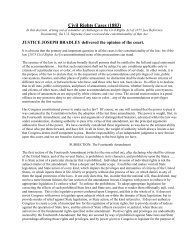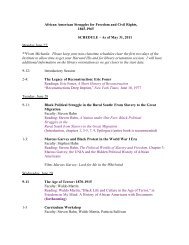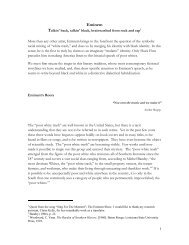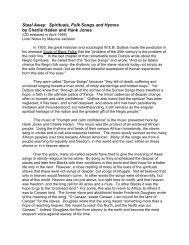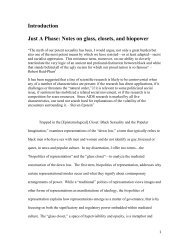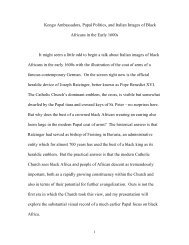SNYC, SNCC, Black Student Activism and the Making of the ...
SNYC, SNCC, Black Student Activism and the Making of the ...
SNYC, SNCC, Black Student Activism and the Making of the ...
Create successful ePaper yourself
Turn your PDF publications into a flip-book with our unique Google optimized e-Paper software.
14<br />
history, few <strong>SNCC</strong> folk at <strong>the</strong> time saw <strong>the</strong>mselves in <strong>SNYC</strong>, <strong>and</strong>, as noted previously, scholarship <strong>and</strong><br />
popular underst<strong>and</strong>ing reflects this notion. 34 <strong>SNCC</strong> veterans, like <strong>the</strong> legendary Robert Moses, admit that <strong>the</strong>y<br />
simply had no prior knowledge <strong>of</strong> <strong>SNYC</strong>, notably as <strong>the</strong>y created early <strong>SNCC</strong>. Yet, even as <strong>SNCC</strong> veterans<br />
<strong>and</strong> scholars <strong>of</strong> <strong>SNCC</strong> have learned <strong>of</strong> <strong>SNYC</strong>’s history, this knowledge has not substantially altered <strong>the</strong><br />
insularity <strong>and</strong> narrowness <strong>of</strong> <strong>SNCC</strong>’s origins narratives. 35<br />
The venerable Ella Baker, <strong>SNCC</strong>’s midwife, clearly knew <strong>of</strong> <strong>SNYC</strong>. Baker herself came <strong>of</strong> age<br />
politically in 1930s New York City, working in a cauldron <strong>of</strong> activism, especially youth/student activism. For<br />
a time she worked in George Schuyler’s Young Negroes Cooperative League. The lessons learned from<br />
<strong>SNYC</strong>’s history, in particular its demise at <strong>the</strong> h<strong>and</strong>s <strong>of</strong> Red Scare-Cold War repression, were not lost on Ms.<br />
Baker. While no militant anti-Communist herself, she fully understood that <strong>SNCC</strong> must remain independent,<br />
non-sectarian <strong>and</strong> as non-ideological as possible. As noted previously, her pr<strong>of</strong>oundly influential counsel<br />
steered <strong>SNCC</strong> in that direction. While <strong>SNCC</strong> was created in <strong>the</strong> throes <strong>of</strong> <strong>the</strong> rapidly developing Sit-In phase<br />
<strong>of</strong> <strong>the</strong> Civil rights Movement, at <strong>the</strong> time <strong>the</strong>re was apparently no substantial discussion <strong>of</strong> <strong>the</strong> history <strong>of</strong><br />
African-American youth/student activism, such as that <strong>of</strong> <strong>the</strong> Sou<strong>the</strong>rn Negro Youth Congress. 36<br />
Howard Zinn, ano<strong>the</strong>r <strong>of</strong> <strong>the</strong> early adult advisors to <strong>SNCC</strong>, like Baker, was not a knee-jerk anti-<br />
Communist. At <strong>the</strong> moment <strong>of</strong> <strong>SNCC</strong>’s founding, he, too, saw <strong>the</strong> organization’s non-ideological focus, its<br />
non-sectarianism, as a strength ra<strong>the</strong>r than a liability. In turn, Zinn touched upon a paradox that underlay<br />
<strong>SNCC</strong>’s viability, notwithst<strong>and</strong>ing its radicalism, especially in <strong>the</strong> early 1960s. Speaking to Daniel Bell’s<br />
consensus vision <strong>of</strong> The End <strong>of</strong> Ideology in postwar America, this paradox was <strong>the</strong> non-ideological character<br />
<strong>of</strong> “’participation in ideological movements today.’” As Zinn observed in his invaluable 1964 attempt “to<br />
suggest <strong>the</strong> quality <strong>of</strong> <strong>the</strong>ir contribution to American civilization,” <strong>SNCC</strong> had “a different quality that that <strong>of</strong><br />
earlier American student movements—<strong>the</strong> radical student movements <strong>of</strong> <strong>the</strong> thirties”: to reiterate — <strong>the</strong> nonideological<br />
character <strong>of</strong> this ideological movement. 37 In o<strong>the</strong>r words, early <strong>SNCC</strong> sidestepped <strong>the</strong> radical<br />
partisan politics that enlivened youth/student movements <strong>of</strong> <strong>the</strong> 1930s <strong>and</strong> contributed to <strong>the</strong>ir undoing when<br />
<strong>the</strong> antiradicalism <strong>of</strong> <strong>the</strong> Red Scare-Cold War was unleashed.<br />
Zinn explained that unlike youth/student activists <strong>of</strong> <strong>the</strong> 1930s, apparently like those <strong>of</strong> <strong>SNYC</strong>, <strong>the</strong><br />
1960s youth/student activists <strong>of</strong> <strong>SNCC</strong> “have not become followers <strong>of</strong> any dogma, have not pledged<br />
<strong>the</strong>mselves to ant rigid ideological system. Unswerving as <strong>the</strong>y are in moving towards certain basic goals,<br />
<strong>the</strong>y wheel freely in <strong>the</strong>ir thinking about society <strong>and</strong> how it needs to be changed.” In essence, <strong>SNCC</strong> activists<br />
“are radical, but not dogmatic: thoughtful, but not ideological. Their thinking is undisciplined; it is fresh, <strong>and</strong><br />
it is new.” At ano<strong>the</strong>r point, he likewise noted that “These are young radicals; <strong>the</strong> word ‘revolution’ occurs


